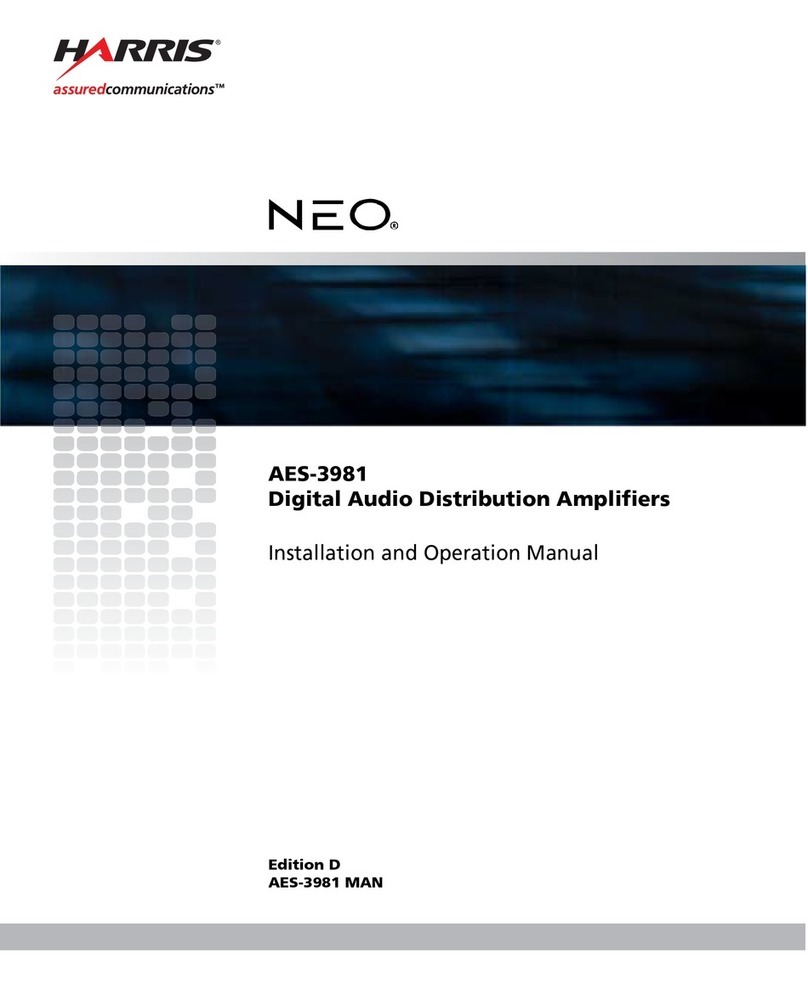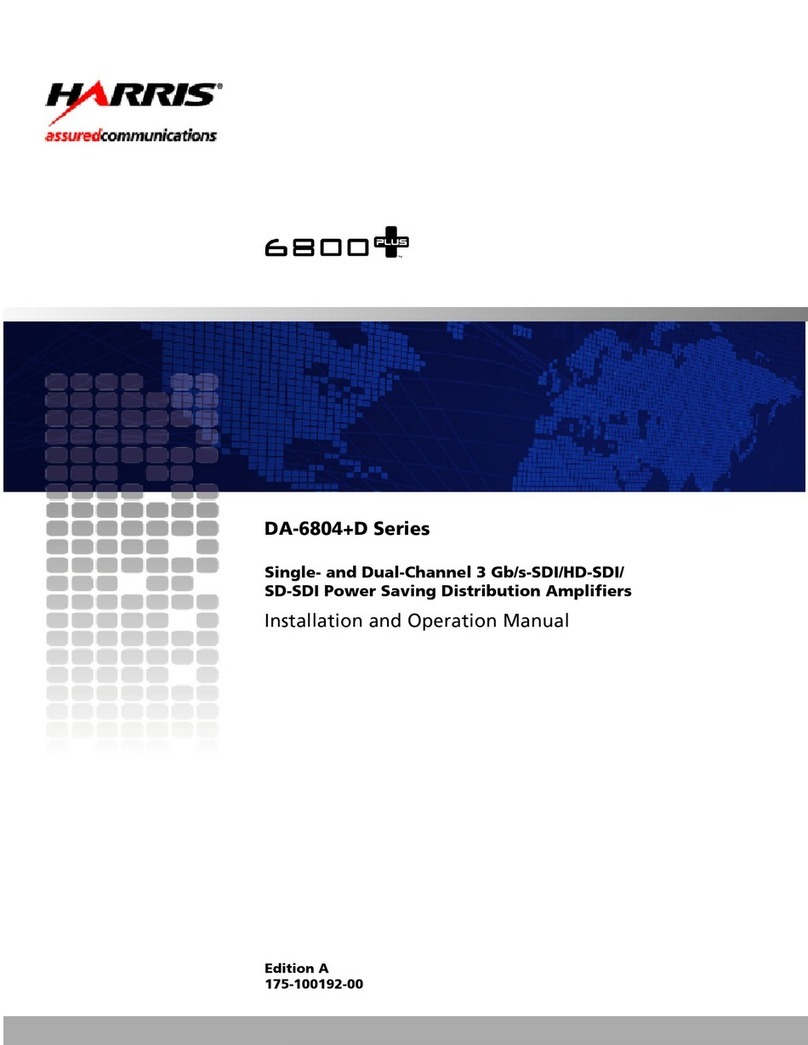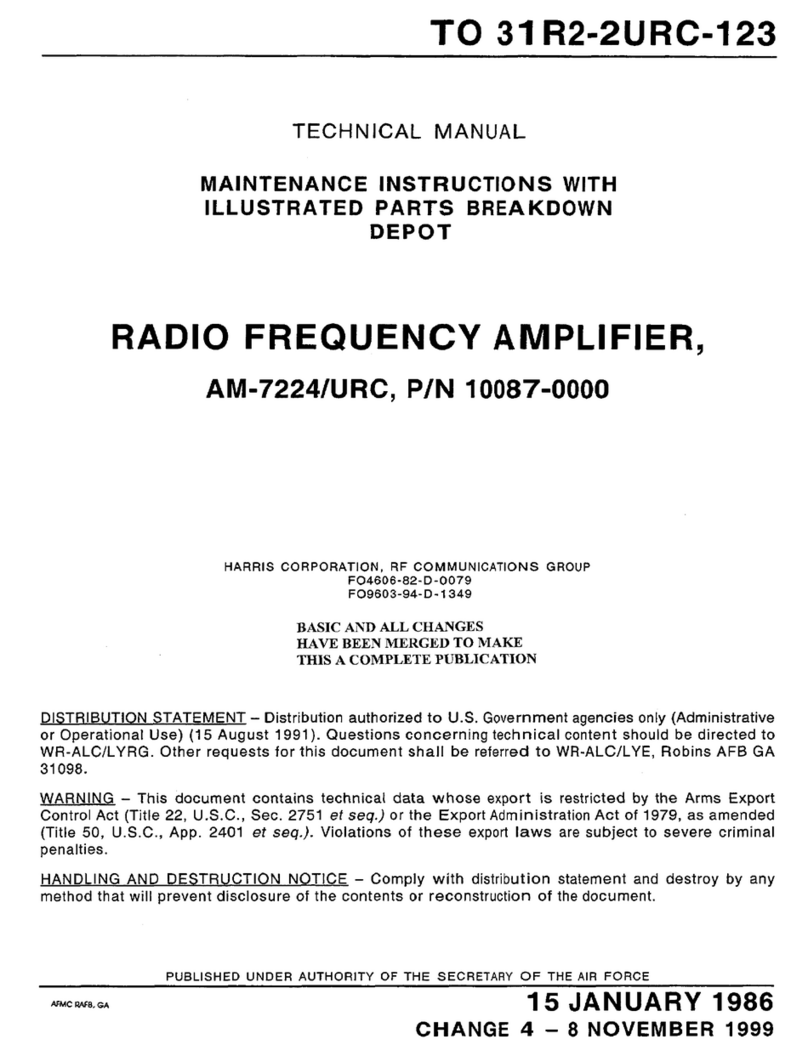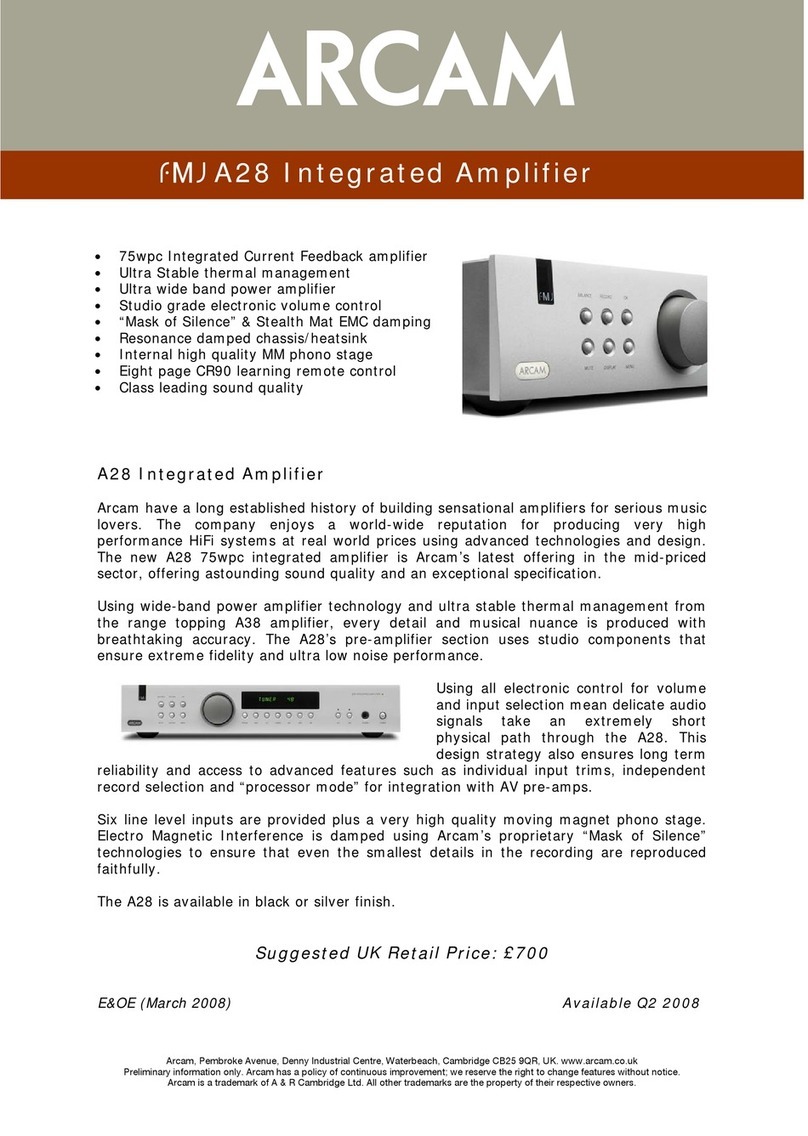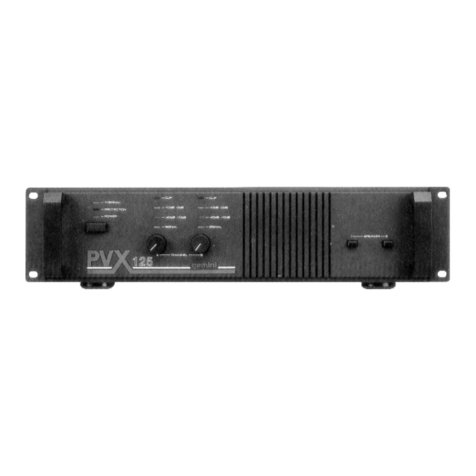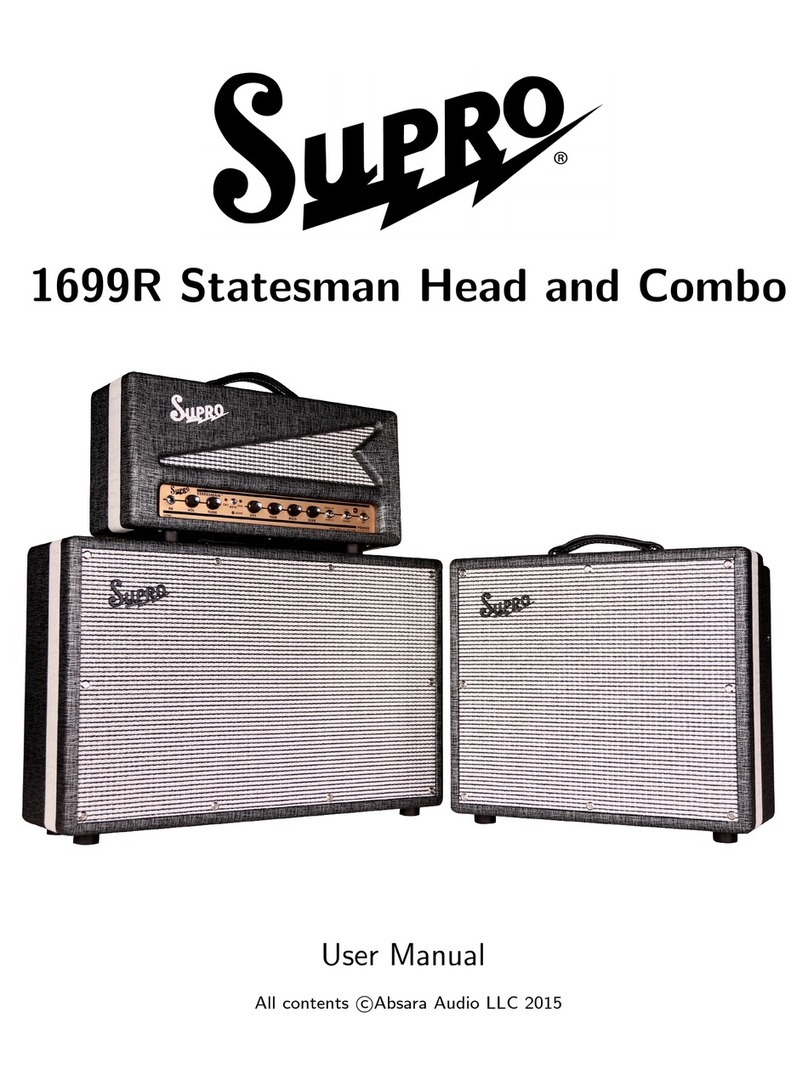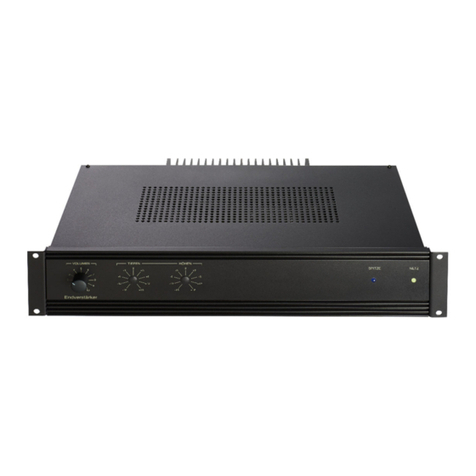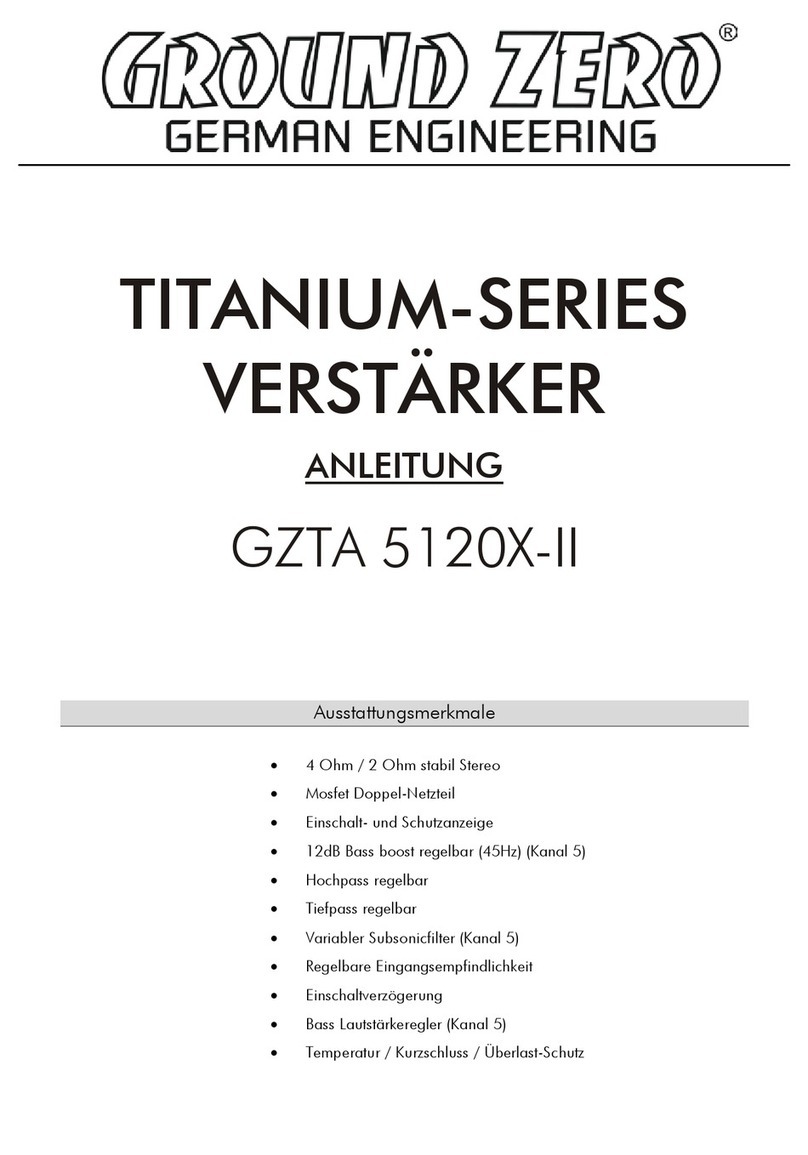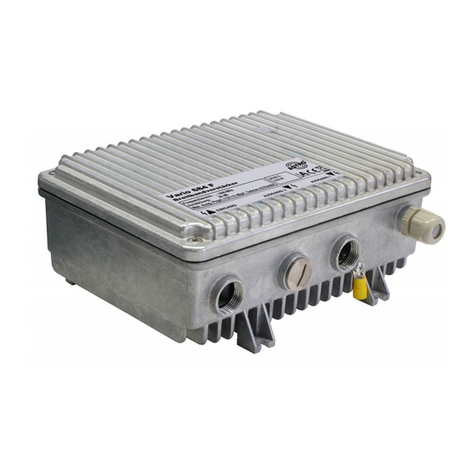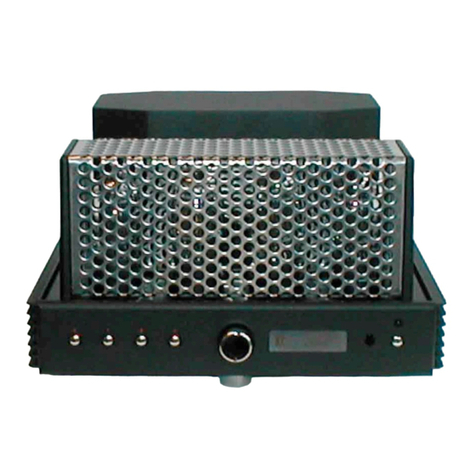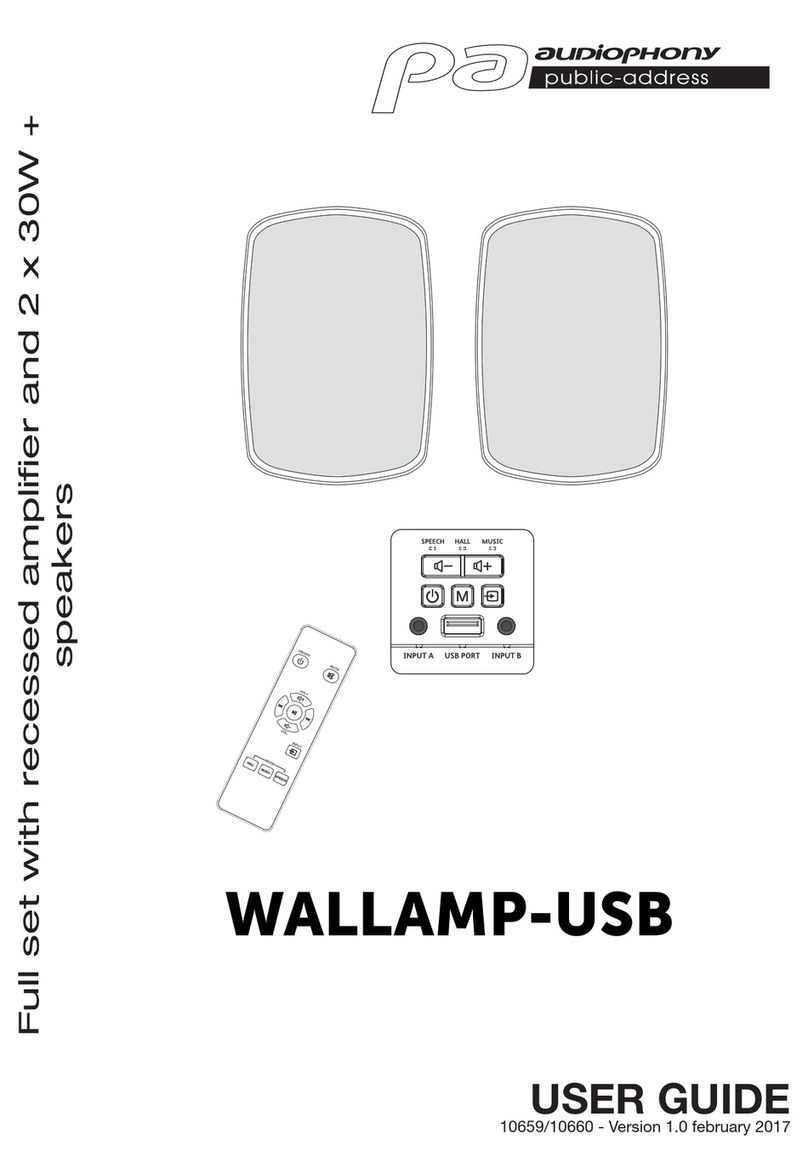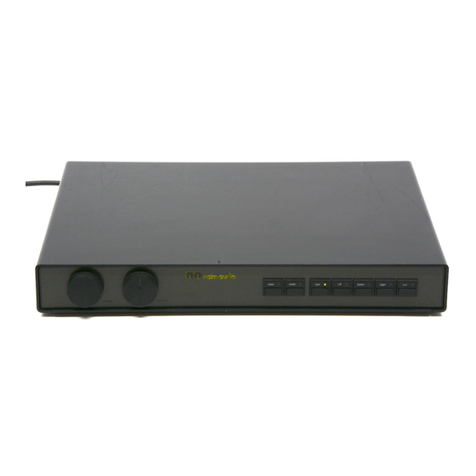Harris GATES M-6035 User manual

1USTRUCTION
EGUK
INSTRUCTION
BOOK
FOR
M-6035
CUE-
INTERCOM
AMPLIFIER
88 -
108
MC
r1=-71
tib
Q d
eizià
;
ES
Juno
1965
GATES
RADIO
COMPANY •
QUINCY,
ILLINOIS
e
62301
o
U.S.A.
A
Division
of
Harris-Intertype
Corporation

•
•
•

INSTALLATION
AND OPERATING
1.1STRUCTION
FOR
M-6035
CUE-
INTERCOM
AMPLIFIER
•
GAIN:
FREQUENCY
RESPONSE:
HARMONIC
DISTORTION:
NOISE:
SOURCE
IMPEDANCE:
OUTPUT
LOAD
IMPEDANCE:
MAXIMUM
INPUT
LEVEL:
MAXIMUM
OUTPUT
LEVEL:
TECHNICAL
DATA
86
DB ±
2
DB @
1
KC
Variable -
Requires
10K
varia-
ble
resistor. (
Part
of
Console)
Peaked
for
maximum
intelli-
gibility.
Under
4%
at +
28
DBM (.
6
W)
at
mid-
band
frequencies.
-105
DBM
equivalent
input
noise.
45
Ohms.
45
Ohms. (
High
Impedance
Speaker)
-40
DBM.
+30
DBM.
MAXIMUM
OPERA-
TING
AMBIENT
•
TEMPERATURE:
55°
C. (
131°
F.)
MAXIMUM
STORAGE
AMBIENT
TEMPERATURE:
85°
C. (
185°
F.)
POWER
REQUIRE-
MENTS: -
37
V.
DC (
unregulated)
10 -
75
ma.
•
TRANSISTORS:
1
-
2N214
2
-
2N1183
3
-
2N1414
1
-
2N5088
1
-
2N5087
SIZE:
3-1/4"Wide
x
7-1/2*Long
x
1"
Thick.
DESCRIPTION
The
Gates M-6035
Transistor
Cue-
Intercom
Ampli-
fier
is
designed
to
be
used
in
transistor
consoles
for
cueing
and
talkback
purposes.
The
amplifier
utilizes
a
gain
control
for
adjusting
to
different
input
levels.
The
amplifier
is
designed
to
be
fed
from
a
45
ohm
source
and
to
operate
into
a
45
ohm
speaker
or
resistive
load.
The
amplifier
is
designed
to
be
used
with
the
M-6039
mounting
frame,
which
carries
a
mating
re-
ceptacle
for
the
printed
card type
connection.
The
connections
on
the
printed
wiring
board
are
gold
flashed
for
positive
connection
with
the
gold
con-
di
tacts
on
the
mating
receptacle.
WThe
amplifier
requires
a -
37
V.
DC
unregulated
power
source
and
requires
from 10
iña. (
at
average
power
output)
to
a
maximum
of
75
ma. (
at +
28
DBM
output).
THEORY
OF
OPERATION
For
the
purpose
of
explanation,
the
Cue-
Intercom
Amplifier
can
be
considered
to
be
made
up
of
two
distinct
parts:
The
preamplifier,
and
the
power
amplifier.
THE
PREAMPLIFIER
The
two
stage
preamplifier
is
driven
by
an
input
transformer
which
is
somewhat
loaded
by
the
in-
put
resistor.
This
resistor
prevents
excessive
signals
from
being
developed
by
the
speaker
at
its
resonance
frequency,
which
would
over-
drive
the
input
stage.
Both
stages
are
of
the
common
emitter
configuration,
with
direct
coupling
utilized
between
the
stages.
On
the
schematic,
837
9345
001,
it
should
be
noted
that
Q1
is
a
NPN
type
transistor
and
has
its
emitter
returned
to
B-
for
biasing
pur-
poses.
Biasing
is.
accomplished
by
a
combination
of
volt-
age
divider
and
emitter
resistance
as
with
R1,
R2
and
R5.
This
method
of
biasing
also
insures
a
high
degree
of
temperature
stability.
Signal
degenera-
tion
is
also
for
Q2
by
R7.
The
volume
control, (
located
on
the
console)
situa-
ted
between
the
preamplifier
and
power
amplifier,
is
connected
in
reverse,
to
maintain
the
high
source
impedance
at
all
settings that
the
power
amplifier
requires.
THE
POWER
AMPLIFIER
The
output
stages
of
the
power
amplifier
operate
Class
B,
and
are
arranged
in
the
circuit
configura-
tion
known
as "
single
ended
push-pull",
or "
follow-
ed
emitter
follower".
The
upper
and
lower
units
are
in
series
across
the
power
supply,
and
the
load
is
connected
at
their
junction,
when
the
signal
at
the
collector
of
Q4
goes
negative
Q6
and
Q8
conduct,
since they
are
all
PNP
types.
When
the
signal
goes
positive
Q5
and
Q7
conduct
since
Q5
is
a
NPN
type.
Thus,
the
full
signal
appears
at
the
junction
point.
Note
that
Q4
is
the
only
stage
in
the
power
ampli-
fier
with
this
voltage
gain.
A
high
frequency
trans-
istor
is
used
at
this
point
to
improve
stability.
Several
feedback
loops
are
employed
in
this
cir-
cuit,
including
R10,
C7,
C10,
and
C9,
C7
and
C10
provide
high
frequency
stability,
C12
supplies
posi-
tive
feedback
from
the
output
to
the
collector
cir-
cuit
of
Q4
to
increase
the
signal
handling
capability
of
this
stage.
MAINTENANCE
PREVENTIVE
MAINTENANCE
The
M-6035
Cue-
Intercom
Amplifier
is
designed
for
long,
trouble-
free
service.
However,
as
with
all
high
quality
electronic
equipment,
a
regular
program
of
inspection
should
be
followed.
It
is
recommended
that
when
the
amplifier
is
first
received,
part
of
the
console,
D.C.
voltage
be
measured
with
the
same
voltmeter
that
will
be
used
for
maintenance
and
troubleshooting,
and
these

I
•
0

2
readings
be
recorded
on
the
amplifier
schematic
a-
bove
the
typical
voltages
shown.
SERVICING
When
servicing
the
amplifier,
the
following
points
should
be
observed.
1.
The
condition
of
the
output
stage
measuring
the
speaker bus
voltage
at
the
junction
of
R21
and
the
collector
6f
Q8.
2.
Circuit
resistances
should
be
measured
only
af-
ter
removing
the
associated
transistor or
trans-
istors,
to
prevent
damage
due
to
ohmmeter
bat-
tery
voltage.
3.
DO NOT
remove
or
insert
transistors
with
the
power
ON.
4.
DO
NOT
probe
the
printed
board
with
a
metal
probe
with
the
power
ON.
5.
Circuit
voltages
are
reversed
from standard
va-
cuum
tube
practice,
as
is
the
polarity
of
all
electrolytic
capacitors.
6.
The
location
of
the
positive
end
of
each
elec-
trolytic
capacitor
is
indicated
by
the
white dot
marked
on
the top
of
the
circuit
board.
PARTS
LIST
Symbol
No.
Gates
Stock
No.
Description
Cl,
C2, C3,
C4,
C9
522
0242
000
Cap.,
25
mfd,
25
V.
C5
506 0005 000
Cap., .
1
mfd.,
200
V.
C6
522 0178
000
Cap.,
25
mfd.,
6
V.
6 —
—37 ','
DC —
1T111NPUT
—
(T1)1NPUT—
VOL.
CONT.
AR
NI
—
VOL
.
CONY •
TOP —
11+60NO.
RETUI:N —
OUTPUT —
•
—T
1
sccor4r.trr
GREEN
Ti 5E
CONDARY
ILACK
Symbol
No.
C7,
C8
C12
C13
C14
Q1
Q6
Q2,
Q3, Q4,
Q5
Q7,
Q8
Gates
Stock
No.
Description
516
0054
000
Cap., .
001
mfd.,
1KV,
10%
522
0256
000
Cap.,
20
mfd.,
50
V.
522
0246
000
Cap.,
100
mfd.,
25
V.
506
0006
000
Cap., .
25
mfd.,
200
V.
506
0004
000
Cap., .
05
mfd.,
200
V.
380
0115
000
Transistor,
2N5088
380
0011
000
Transistor,
2N214
380
0112
000
Transistor,
2N5087
380
0014
000
Transistor,
2N1414
380
0012
000
Transistor,
2N1183
121
R2,
R3
R4
R5
R6
R7,
R8
R9,
R19,
R20
R10,
R14
RII
R12,
R18
R13
R15
R16
R23
R2,4
R21,
R22
R25
R17
Tl
XD1,
XD2
XQ1,
XQ2,
XQ3, XQ4,
XQ5,
XQ6
XQ7,
XQ8
540
0081
000
540
0071
000
540
0076
000
540
0075
000
540
0057
000
540
0036
000
540
0045
000
540
0041
000
540
0073
000
540
0085
000
540
0039
000
540
0098
000
540
0049
000
540
0070
000
540
0017
000
540
0023
000
540
0005
000
540
0845
000
540
0025
000
478
02851)00
Res.,
22K
ohm,
1/2
W.,
5%
Res.,
8200
ohm,
1/2
W.,
5%
Res.,
13K
ohm,
1/2
W.,
5%
Res.,
12K
ohm,
1/2
W.,
5%
Res.,
2200
ohm,
1/2W.,
5%
Res.,
300
ohm,
1/2W..
5%
Res.,
680
ohm, 1/2
W.,
5%
Res.,
470
ohm,
1/2
W.,
5%
Res.,
10K
ohm,
1/2
W.,
10%
Res.,
33K
ohm,
1/2
W.,
5%
Res.,
390
ohm,
112W.,
5%
Res.,
110K
ohm,
1/2
W.,
5%
Res.,
1K
ohm,
1/2
W.,
5%
Res.,
7500
olun,
1/2W.,
5%
Res.,
47
ohm,
1/2
W.,
5%
Res.,
82
ohm,
1/2
W.,
5%
Res.,
15
ohm,
1/2W.,
5%
Res.,
6.8
ohm,
1/2
W.,
5%
Res.,
100
ohm,
1/2W.,
5%
Transformer,
Input
404
0227
000
Dissipator
404
0066
000
Socket
404
0149
000
Socket
Ti
01
'
lo
03
05
4.
C12
06
122
07
C13

I
•
•

e
45.1
DI.Vr
..
.
.(
µ4
.1
Llee
1.
-37
G,'
-
Zo.
6
es
<
serge
RADIO
CON
•USCV.
Wools
C-79.eq
e
/CALI
100 100
1. 1.
108
101
LIST
OTT.
Orr
on
OTT
OTY
11001
ION
DITOCIDITION
1.11{01.01..
R 5
-37
~V.A.
I 2 K
.C2
•
.--*
2572e
R
C.
2.2K
RIO
tor.
-12.9
R/4
ioK
C e
25/2.5
R/.3
3.0
eie
he
2N/4‘e
/7/4
xQe
ZeK
2,.
I /
el
x4
,7
-‘9.8e.
el.
77)
• 5
_
t
20/54
C7
+
.001
(to,o1)
/oo
-18
Bo
(9
4o)
18
Bo'
e,,
470
2
ntso87
XQ2
-
zo•o
.
CC
2r4
Zdv/ell
>4'
(
23
-O.
IG
/toe'
IN14
xQ4-
-
96
01
2N2I4
X Q
t•
0.
3)
2
NI
I.5.3
XQ
a
(lo)
Q'
75
)
Cl
• /
Q0.01
-
-.82
e7
300
.022)
_
+
'9
7:
33J(e/2
,
c.zo
390
8.70
—.001
(1."a
5)
C41
25/25
-
R8
_
éBa
-•,.
3
RA5
e o
4'70
Zo /
2
2Z
.o
re
(.47)
CI
5
C13
.
25
R23
47
rttrAmera-c
,
ALL
CAP. ///
MFD
W/TIY
D.C.WV
2.
ALL
RES/37
-
0/93
1/2
W.
5%.
3.
D.C.
voLrAeess
meAsuezo
AQA/NST
Be
WITH
20/ell/VOLT
mereR
ON()
SIGNAL.
4. ()
RAIS
vOLrACE
meoreneo4r
mec
Jer.VA
-
ect
eAmi
i.y.e
V
A'
el
our
ushv(2
h'°
vrme
t
5.
0
INDICATES
SOLDER LUG
In
1Y)
NJ
•TAT1.1111
s
e
.4
k
oat
,
z
e3
0•111.11.10t1r1
••••••••••
C
rig —
re
-C
SCHEMATIC
DIAGR.Arsi
ee_se"
‘cP-
DAR
110.
OS
..
e,r
)
CHSY
•
00TkI
.‘
1.
c-
7f'5
101011.
OP

•
•
•

1
INSTALLATION
AND
OPERATING
INSTRUCTIONS
FOR
M-6034
TRANSISTOR
PREAMPLIFIER
TECHNICAL
DATA
GAIN:
45
DB ±
1
DB
operated
into
a
600
ohm
load.
FREQUENCY
RESPONSE: ±
1
DB,
30
cps
to
15,000
cps.
HARMONIC
DISTORTION:
Under 0.5%
from
50
cps
to
15
KC
at +
5
DBM
output.
Under
0.5%
from
30
cps
to
15
KC
at.--
50
DBM
output.
INTERNIODULATION
DISTORTION:
Under
0.5%
at —
5
DBM
output
level,
and
under
1.0%
at +
5
DBM
output
level.
Distortion
measured
at
equiva-
lent
sine
wave
output
using
40
cps
and
7
KC
mixed
4
to
1.
NOISE
LEVEL: —
122
DBM
equivalent
input
noise.
SOURCE
IMPEDANCE:
30/50
and
150/250
ohms.
INPUT
IMPEDANCE:
Input
transformer
unloaded,
re-
sulting
in
input
impedance
being
substantially
higher
than
source
impedance.
OUTPUT
LOAD
IMPEDANCE:
MAXIMUM
INPUT
LEVEL:
MAXIMUM
OUTPUT
LEVEL:
600
ohms ±
10%.
—40
DBM.
+5
DBM.
MAXIMUM
OPERATING
AMBIENT
TEMPERATURE:
55°
C. (
131°
F.)
MAXIMUM
STORAGE
AMBIENT
TEMPERATURE:
POWER
REQUIRE-
MENTS:
TRANSISTORS:
MOUNTING:
85°
C. (
185°
F.)
—30
V.
DC
at
15
ma
with
less
than .
1
MV
ripple.
3 -
2N5087
1 -
40319
Requires
M-6039
mounting
frame.
SIZE:
3-1/4"
Wide
x
6-3/8"
Long
x
1"
Thick.
DESCRIPTION
The
Gates
M-6034
Transistor
Preamplifier
is
a
premium
quality
low
noise
unit
for
use
in
consoles,
and
is
com-
pletely
temperature
conipensated
using
the
latest
tech-
niques.
The
amplifier
has
a
gain
of
45
DB
with
a
maxi-
mum
output
is
unbaraneed
and
transformerless,
which
is
designed
to
operate
into
a
600
ohm
variable
attenua-
tor.
The
input
is
balanced,
and
is
connected
for
150/250
ohm
source
impedance
at
the
factory
but
may
be
recon-
nected
for
30/50
ohms.
THEORY
OF
OPERATION
This
amplifier
is
designed
to
provide
a
fixed
gain of
45
DB.
It
is
a
four-
stage
amplifier
and
utilizes
a
trans-
formerless
output.
It
features
negative
feedback
to
re-
duce
distortion
to
a
very
low
level
and
minimizes
specification
changes
with
transistor
changes.
Signal
is
applied
to
pins
C
and
E
and
is
fed
through
transformer,
Ti,
to
the
base
of
Q1 (
2N1307).
Q1
is
a
low
noise
transistor
operated
at
ideal
collector
current
for
minimum
noise.
It
will
be
noted
that
the
first
stage
is
series
fed
through
Ti
to
provide
the
maximum
input
gain
from
Ti.
Cl
and
R1
are
connected
across
the
secon-
dary of
Ti
to
stabilize
the
amplifier.
The
value
of
R1
and
Cl
were
picked
to
provide
a
roll
off
above
the
audio
range
to
prevent
amplification
of
very high
frequency
noise.
The
signal
is
then
direct
coupled
from
the
collector
of
Q1
to
the
base
of
Q2.
Q2 .
is
a
very
high
gain
stage
be-
cause
the
emitter
is
completely
by-passed.
The
signal
is
then
coupled
from
the
collector
of
Q2 (
thru
C8)
to
Q3.
The
collector
of
Q3
is
direct
coupled
to
the
base
of
Q4.
Q4
is
an
emitter
follower.
Emitter
followers
are
very
stable
and
are
virtually
distortionless.
This
also
provides
the
low
output
impedance
required
to
feed
a
600
ohm
fader.
Feedback
is
applied
from
R17
through
R13
and
C9,
R7
and
C5
to
the
emitter
resistor
(R6) of
the
first
stage.
R13
and
C9
provide
a
boost
of
1
DB
at
30
cps
to
make
the
response
flat
in
the
audio
range.
MAINTENANCE •
Transistor
amplifiers
are
designed
for
a
long
trouble-
free
life,
however,
dust
and
dirt
can
cause
trouble.
A
monthly
dusting
with
a
soft
brush
should
be
adequate.
SHOULD
TROUBLE
OCCUR -
Step
1 -
First
check
all
DC
voltages.
The
DC
voltages
determine
the
bias
points
of
the
transistors
and
any
departure
of
20%
or
more
should be
considered
a
defect.
NOTE:
Use
of the
resis-
tance
chart
will
help
detect
faulty
components.
Step
2 -
Before
any
signal
measurements
are
made,
re-
place
any
defective
parts
to
make
DC
voltages
correct.
Step
3 -
After
all
DC
voltages
are
correct,
signal
tests
may
be
performed.
The
correct (
RMS)
voltages
are
shown
on
the
schematic
diagram.
Voltages
shown
are
for —
40
DBM
input
150
ohms
not
terminated.
DO
NOT
remove
or
insert
transistors
with
the
power
ON.
Gates Radio
Company
Quincy,
Illinois

•
•
•

2
REMEMBER -
In
this
transistor
circuitry
B+
is
ground,
therefore,
capacitors
have
the
positive side
connected
to
ground.
S
NOT
probe
the
printed
board
with
the
power
ON
with
a
metal
screwdriver,
etc.,
that
could
short
out
wiring.
If
-
(-30V)
e+
(ORD )
IN
C.7
IN
OUTPUT
PI
TI
PRIMARY
IMP.
1500.
500.
cr
vv
YEL.
Il
ONO
TS
Jt.
V.,
To
et
•
1
OCT
TO
IbluE
e
ERN.
154..VE •
YEL
Symbol
No.
Gates
Stock
No.
Description
Cl
508
oc349
000
C2
522
0178
000
C3
522
0160
000
C4,
C7, C8,
C10
522
0242
000
C5
500
0759 000
C6
522
0187
000
C9
522
0158
000
Ql,
Q2,
Q3
380
0112
000
Q4
380
0171
000
R1
540
0035
000
R4
548
0050
000
R3
540
0062
000
R5
540
0066
000
R6
548
0049
000
R7
540
0038
000
R8
540
0077
000
R9
540
0068
000
R10
540
00(34
000
R11
540
0081
000
R12
540
0062
000
R13
540
0025
000
R14
540
0084
000
R15
540
0048
000
R16
540
0063
000
R17
540
0036
000
R18
540
0058 000
R2
540
0076
000
Ti
478
0285
000
XQ4
404
0198
000
-14
Na
-30
Cap., .
0075
uf,
100
V.
Cap.,
25
uf,
6
V.
Cap.,
100
uf,
3
V.
Cap.,
25
uf,
25
V.
Cap.
100
PF,
500V.
Cap.,
200
uf,
6
V.
Cap.,
50
uf,
3
V.
Transistor
2N5087
Transi
stiir -
10319 (
Selected)
Res.,
2'70
ohm,
1/2W.,
5%
Res.,
20K
ohm,
1/2
W.,
1%
Res.,
3600
ohm,
1/2
W.,
5%
Res.,
5100
ohm,
1/2
W.,
5%
Res.,
100
ohm,
1/2
W.,
1%
Res.,
360
ohm,
1/2
W.,
5%
Res.,
15K
ohm,
1/2
W.,
5%
Res.,
6200
ohm,
1/2
W.,
5%
Res.,
4300
ohm,
1/2
W.,
5%
Res.,
22K
ohm,
1/2
W.,
5%
Res.,
3600
ohm,
112
W.,
5%
Res.,
100
ohm,
1/2
W.,
5%
Res.,
30K
ohm,
1/2
W.,
5%
Res.,
910
ohm,
12
W.,
5%
Res.,
3900
ohm,
1/2W.,
5%
Res.,
300
ohm,
1/2
W.,
5%
Res.,
2400
ohm,
1/2W.,
5%
Res.,
13K
ohm,
1/2W.,
5%
Transformer,
Input
Transipad
I)
DC
VOLTAGE,
ARC
TYPICAL
ANO
WERE
READ
WITH
A .
504PSbN
EGO.
5)
VOLTAGES
314044
AS (—) ARE
SIGNAL
VOLTAGES.
3)
ALL
Re5/5TORS
I/O
WATT,
Sit
EXCEPT •
4)
ALL
CAPACITORS
IN
0400,
WITH
OC
W
V.
3.)
0
INDICATES
SOLDER
LUG

•
•
•

•
_
dir
Fig.
1 -
M5700
Transistor
Program
Amplifier
•
The
Gates
Transistor
Program
Amplifier
is
available
in
two
versions:
I.
The
M5700
is
designed
specifically
for
use
in
Gates
Transistor
Consoles.
It
is
supplied
less the
interstage
level
control,
and
with
the
input
unterminated.
The
con-
trol is
mounted
externally
on
the
Console
panel.
2.
The
M5700B
is
designed
for
rack
mount-
ing
in
system
installations
with
the
level
control
mounted
internally.
The
input of
the
amplifier
is
unterminated
to
facilitate
application.
Terminate
the
input
connect -
ions
on
the
amplifier
mounting
tray
in
the
proper
resistance (
150
or
600
ohms).
The
gain
of
the
M5700B
will
then
be
approxi-
mately
70
db
maximum.
TECHNICAL
DATA
Gain:
M5700:
80
DB,
M5700B:
76
DB,
may
be reduced
as
required
with
internal
volume
control.
Frequency Response:
+ 1
db
from
30
to
15,000
cps.
Harmonic
Distortion:
Under
0.75%
at
30
cps.,
0.5%
from 50
to
15,000
cps.,
at +
24
dbm
output.
Intermodulation
Distortion:
Under
0.3%
at +
14
dbm
equivalent
sine
wave
power
output,
using
40
and
7000
cps..,
mixed
4:1.
Under
1.5%
at +
24
dbm.
Noise
Level:
-122
dbm
equivalent
input
noise.
Source
Impedance:
150/250
ohms,
or
500/600
ohms.
Input
Impedance:
Factory
connected
for
150
ohms.
May
also
be
connected
for
600
ohms.

1
•
s
s

1
Load
Impedance:
Factory
connected
for
600
ohms.
•
also
be
connected
for
150
ohms.
te
Maximum
Input
Level:
-35
dbm.
Maximum
Output
Level:
+24
dbm.
Maximum
Operating
Ambient
Temperature:
55°C. (
131°
F.)
Maximum
Storage
Ambient
Temperature:
85°
C. (
185°
F.)
Power
Requirements:
30
volts
D.C.,
90
ma.,
0.1
mv.
maximum
ripple.
Transistors:
4 -
2N1414
2
-
2N5087
1
-
2N1183
May
Finish:
Satin-
silver
cover,
black
escutcheon
plate.
Mounting:
M6031
Mounting
Tray
required
to
mount
in
M6029
Shelf
Assembly.
Shelf
assem-
bly
accommodates
seven
Program
Ampli-
fiers
and
requires
panel
space
of
3-1/2"
X
19".
Size:
2-7/32"
wide,
3-1/8"
high,
10-3/4"
long,
overall.
Weight:
4-1/4
lbs.
net.
8-1/4
lbs.
packed.
Cubage:
0.8
Cu.
ft.
domestic
pack.
DESCRIPTION
The
M5700
Program
Amplifier
is
completely
transistorized,
and
is
designed
for
use
as
a
line
or
isolation
amplifier
in
broadcasting
and
recording
applications.
Special
tech-
.
niques
have
been
employed
to
obtain
low
noise,
low
distortion,
and
good
temperature
stability.
The
amplifier
is
used
with
the
M6031
Mount-
ing
Tray
which
carries
a
mating
receptacle
and
is
supplied
with
mounting
hardware.
Up
to
seven
trays
may
be
installed
on
the
M6029
Shelf
Assembly,
which
mounts
in
a
standard -
Gates
rack
cabinet,
and
occupies
3-1/2"
of
panel
space.
A
keying
pin
is
pro
-
0.8
0.6
OA
0.2
o
DB
0
—1
—2
--43
5
vided
with
the
mounting
tray
to
prevent
ac.-
cidental
interchange
of
non-
similar
plug
-
In
units
in
the
system.
The
interstage
level
control
is
located
on
the
front
panel
of
the
M5700B
model.
The
output
transformer
and
receptacle
are
at-
tached
to
the
frame,
and
all
other
compo-
nents
are
mounted on
the
printed
wiring
boards.
Typical
frequency
response
and
distortion
curves
are
shown
in
Fig.
2.
These
meas-
urements
were
taken with
all
transistors
se-
lected
at
random.
\.,...,_
TYPICAL
TOTAL
HARMONIC
DISTORTION
AT +
24
D8Id
OUTPUT
.........
TYPICAL
1
FREQUENCY
RESPONSE
1 i
11
1
150.4x
IN,
600.n.
0uT
I r
—,
10
20
50
100
200 500
IKC
2
KC
5KC
101(C
20/(C
50
813
6380
001
KC
Fig.
2 -
Response
and
Distortion.

•
•
•

2
INSTALLATION
OMOUNTING
TRAY
AND
SHELF
ASSEMBLY
Mounting
holes
have
been
spaced
in
the
shelf
assembly
to
allow
it
to
be
completely
filled
with
trays
of
any one
type
for
the
Gates
transistorized
units.
It
is
possible,
where
maximum
use
of
shelf
space
is
not
required,
to
mix
trays
of
different
sizes.
Thus
a
pro-
gram
amplifier
and
preamplifier
could
be
placed
at
the
left
and
a
power
supply
at
the
extreme
right.
Proceed
as
follows:
1.
Locate
the
first
tray
at
the
extreme
left
or
right
of
the
shelf
assembly,
with
the
re-
ceptacle
at
the
rear.
The
countersunk
holes
of
the
tray
will
fit
into
the
matching
holes
in
the
shelf,
when
properly
located.
Leave
a
1/16"
space
between
trays.
2.
Secure
the
tray
to
the
shelf
with
the
two
*4-40
x
1/4"
flat
head
screws
with
the
two
#6
internal-
external
shakeproof
washers
un-
e
der
two #
4
hex
nuts.
GUI
DE
BAR
lir
1313
6350
001
Fig.
3 -
Shelf
Assembly
With
Guide
Bar
3.
Determine
whether
or
not
the
guide
bar,
shown
in
Fig.
3,
will
be
required.
The
pur-
pose
of
this
bar
is
to
prevent
possible
dam-
age
to
the
mating
connectors
when
upward
pressure
is
inadvertently
applied
to
the
am-
plifier
during
withdrawal.
The
bar
will
be
required
only
where
no
other
protecting
ob-
struction
is
present
in
the
rack,
or
where
the
shelf
is
used
at
a
location
such
as
a
work
bench.
It
will
not
be
required
where
another
M6029
.
Shelf
Assembly
is
mounted
directly
above,
or
where
overhead
equipment
interferes
with •D
mounting
of
the
shelf
due
to
the
presence
of
the
bar.
The
mounting
screws
are
locat-
ed so
that
they
may
be
removed
from
within
the
shelf.
4.
Mount
the
shelf
in
the
rack
using
hard-
ware
supplied
with
the rack.
The
two
end
strips
mount
underthe
screw
heads,
and
are
to
be
flush
with
the
drop
panel.
INPUT
AND
OUTPUT
TRANSFORMERS
The
input
transformer
is
factory
connected
for
150
ohms
primary
impedance,
as
shown
on
the
schematic
diagram
and on
Fig.
4.
If
a
terminated
input
is
desired,
a
150
ohm
resistor
should
be
connected
to
terminals
9
and
10
on
the
amplifier
mounting
tray,
since
the
amplifier
input
is
unterminated.
•00FA
ORR
TUT
NIT
SLUE
RED
813
1371
001
Fig.
4 -
Input
Transformer
Connections
Refer
to
Fig.
4
for
connection
to
600
ohms
impedance.
If
a
terminated
input
is
requir-
ed,
connect
a
620
ohm
resistor
across
term-
inals
9
and
10
on
the
amplifier
mounting
tray.
If
6db
more
gain
is
desired
in
some
appli-
cations,
the
input
terminating
resistor
may
be
deleted.
In this
case,
however,
the
system
component
preceeding
the
amplifier
will
not
be
properly
terminated.
The
output
transformer
is
factory
connected
o

e
e
e

3
for
600
ohms
secondary
impedance.
To
re-
.
connect
for
150
ohms
refer
to
the
schematic
•
illidiagram.
Remove
the
green/white
and
black
Wwires
from
terminal #
7.
Connect
the
black
wire
to
terminal #
5
and
the
green/white
wire
to
terminal #
6.
I
EXTERNAL
CONNECTIONS
External
connections
are
made
to
the
mount-
ing tray
receptacle
as
follows:
Circuit
Terminals
External
Control (
Optional)
+30
V.
Circuit
Ground
Output
Connections
Output
Center-
Tap (
600
ohms)
Input
Connections
Input
Center-
Rap
-30
V.
Chasis
Ground
No
Connection
1,2,3
4
4
5,6
7
9,10
11
12
13
8,14,15,16
Jumper
together
all #
13
terminals
on
the
shelf,
whether
program
amplifiers
or
other
types,
and
connect
to
the
rack
ground
bus.
Connection
from
rack
ground
to
the
circuit
ground
in
the
program
amplifier (
B+)
should
be
made
at
the
amplifier (
not
at
the
power
supply).
Make
a
connection
from
the
rack
ground
bus
to
each
amplifier
terminal #
14,
SEPARATELY,
with
at
least
18
guage
wire.
These
circuit
grounds
must be
carried
sepa-
rately
to
prevent
the
possibility
of
interac-
tion (
due
to
mixing
of
return
currents
in
a
common
wire).
Where
other
types
of
amp-
lifiers
are
mounted
on
the
same
shelf,
con-
sult
their
respective
Instruction
Book
for
grounding
information.
Where
many
ampli-
fiers
and
power
supplies
are
mounted
in
a
rack,
it
is
preferable
to
run
a
vertical
rack
ground
bus-
bar, to
pick
up
grounds
at
each
shelf.
Run
the
D.
C.
supply
leads,
output
pair,
and
chassis
and
circuit
ground
leads
along
the
rear
edge
of
the
shelf.
The
D.C.
supply
leads
should
be
at
least
18
gauge,
and
must
be
run
SEPARATELY
from
each
program
amp-
lifier
to
its
respective
power
supply,
to
pre-
vent
the
possibility
of
common
coupling
in
the
power
wiring.
See
the
power
supply
In-
struction
Book
for
further
information.
Run
input
pairs
and
external
control
leads
along
the
shelf
brace,
above
the
receptacles.
EXTERNAL
VOLUME
CONTROL
Reference
to
the
schematic
diagram
will
in-
dicate
that
the
program
amplifier
is
wired
to
accommodate
an
external
volume
control.
This
feature
makes
it
possible
to
locate
the
volume
control
on
an
adjacent rack
panel,
or
on
a
console
control
panel ,
when
the
amp-
lifier
is
mounted
internally.
The
internal
control,
R30,
must
be disconnected
when
the
amplifier
is
to
be
used ,
in
this
way.
The
(R30)
control
may
be
ordered
as
part
number
550
0218
000.
THEORY
OF
OPERATION
For
the
purpose
of
explanation,
the
program
amplifier
can
be
considered
to
be
made
up
of
two
parts:
the
preamplifier,
and
the
high
level
amplifier.
THE
PREAMPLIFIER
The
four
stage
preamplifier
has
a
transform-
er
coupled
input
and
emitter
follower
out-
put,
with
direct
càupling
utilized
between
Q1
and
Q2,
and
between
Q3
and
04.
Q1
and Q2
transistors
are
low
noise
types
de-
signed
for
use
in
critical
low
noise
appli-
cations.
Biasing
is
accomplished
by
a
combination
of
voltage
divider
and
emitter
resistance,
as
with
R2,
R3,
and
R5.
This
method
of
bias-
ing
also
insures
a
high
degree
of
tempera-
ture
stability.
Signal
degeneration
is
pro-
vided
for
Q1 by
RS,
and
for
Q3
by
R17.
A
loop
feedback
network
connects
from
Q3,
thru
R7
and
C5,
to
Q1 •
The
large
amount
of
feedback
and
degeneration
obtained
by
these

O
•
e
Table of contents
Other Harris Amplifier manuals
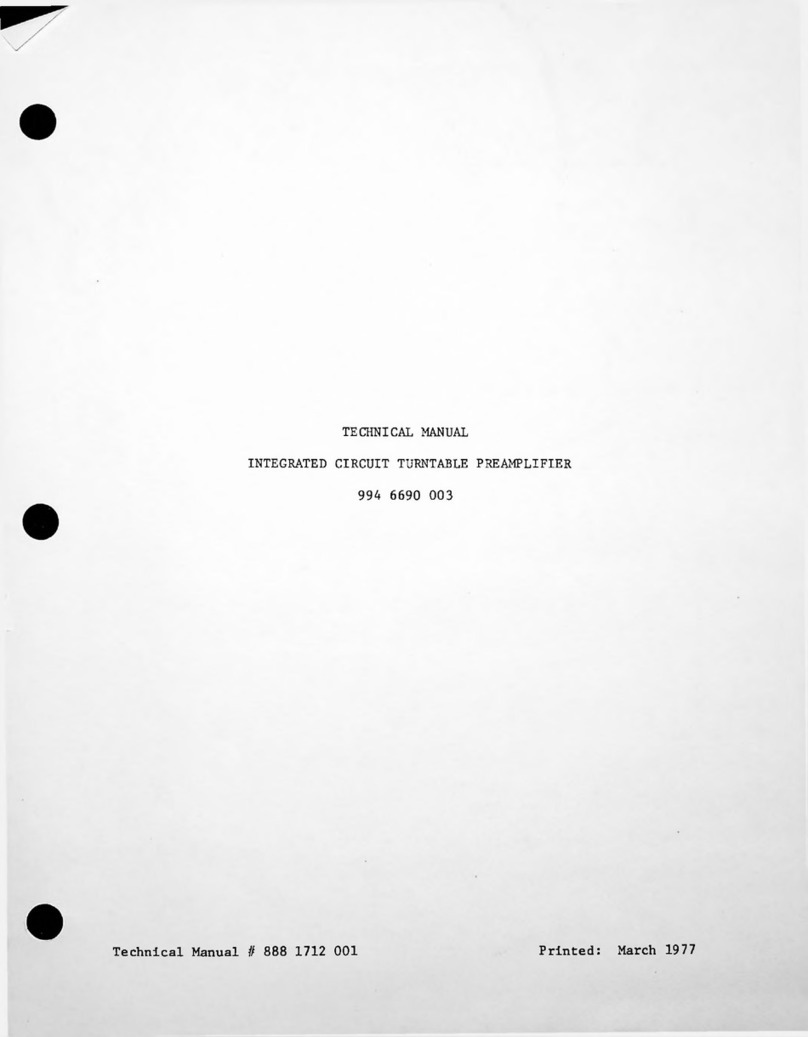
Harris
Harris 994 6690 003 User manual
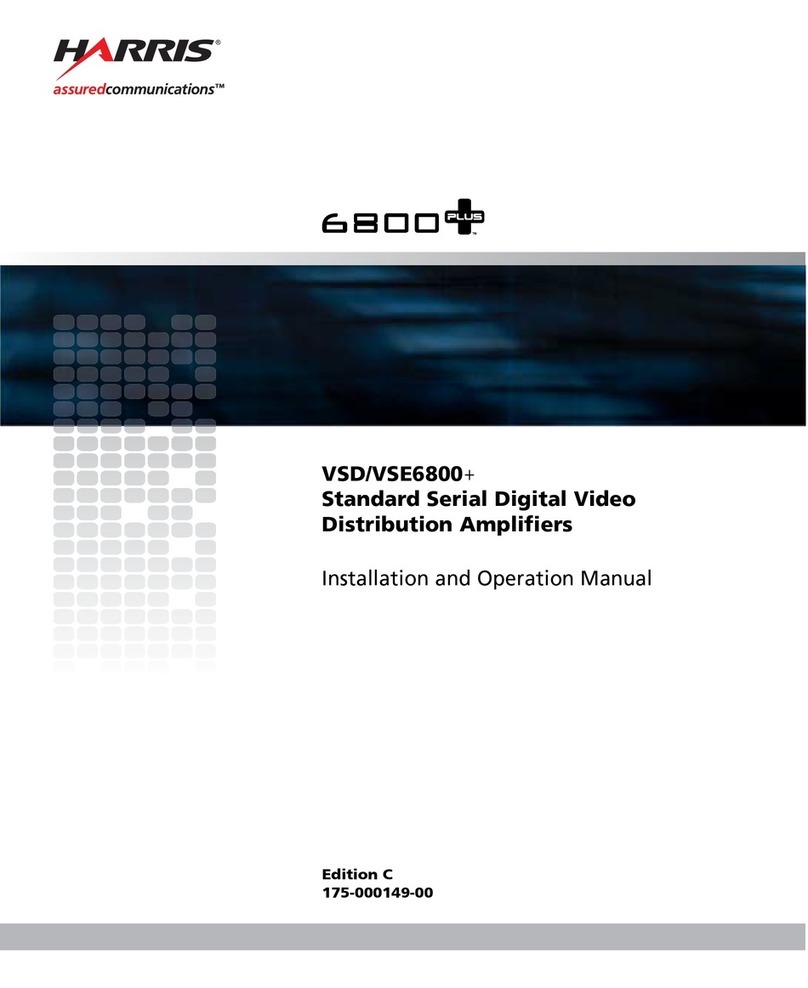
Harris
Harris VSD6800+ User manual

Harris
Harris OPA 8500 User manual
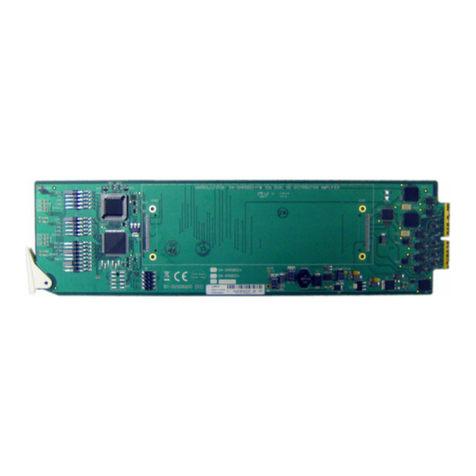
Harris
Harris DA-DHR6802+ User manual

Harris
Harris OPA 8500 User manual
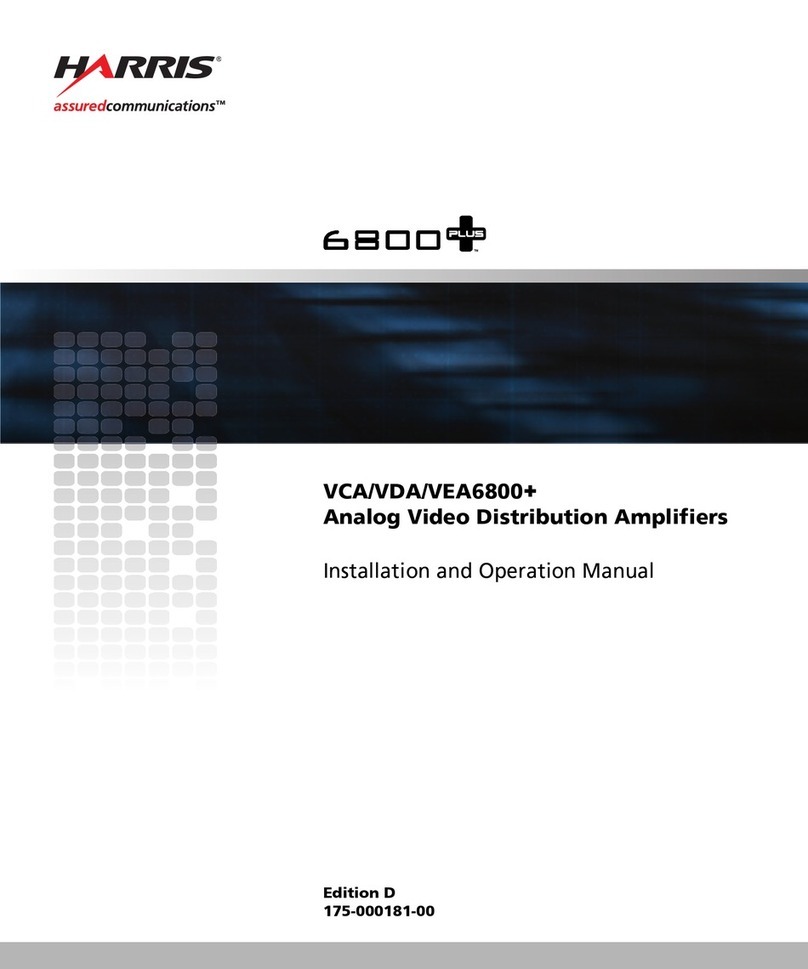
Harris
Harris VCA6800+ User manual
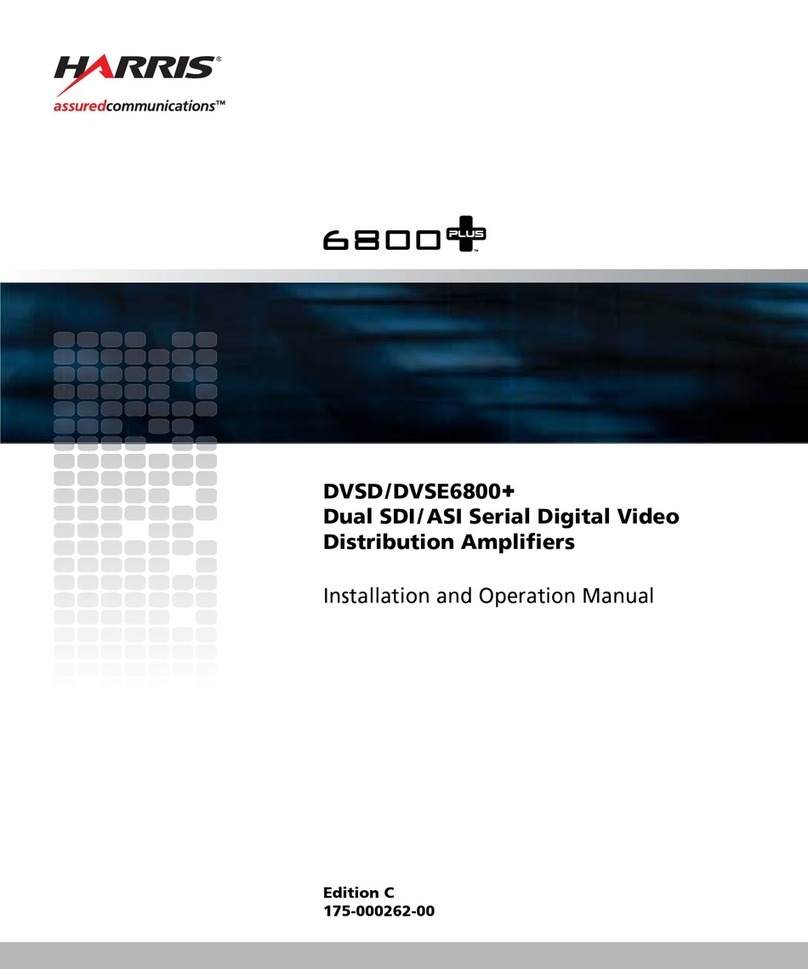
Harris
Harris DVSD6800+ User manual
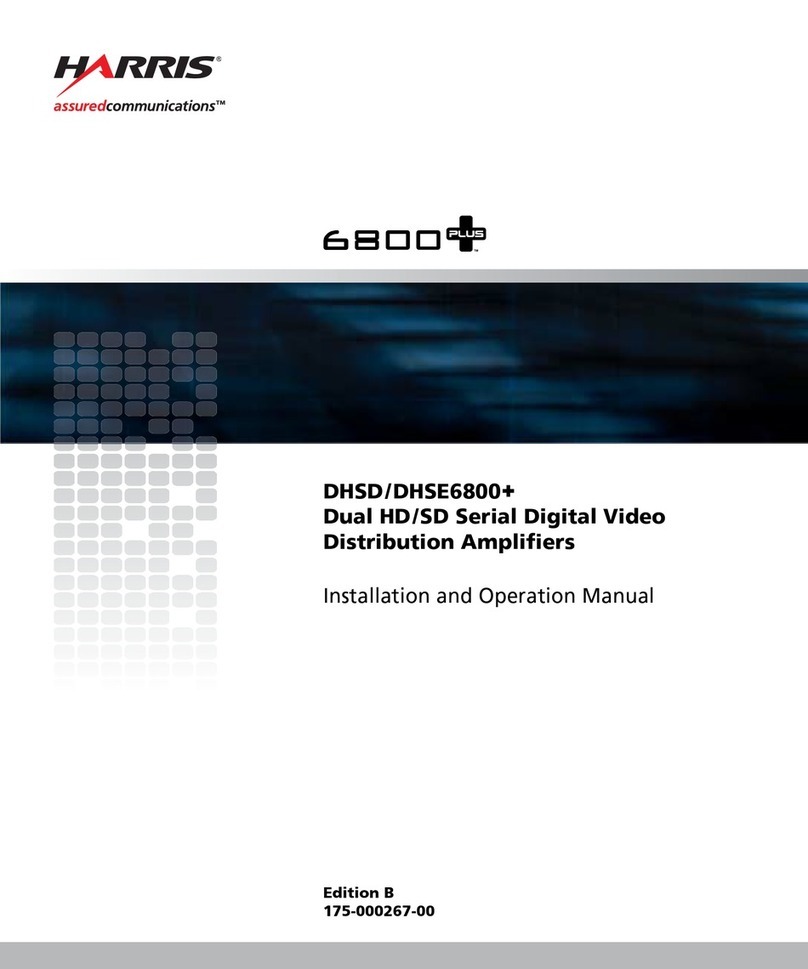
Harris
Harris DHSD6800+ User manual
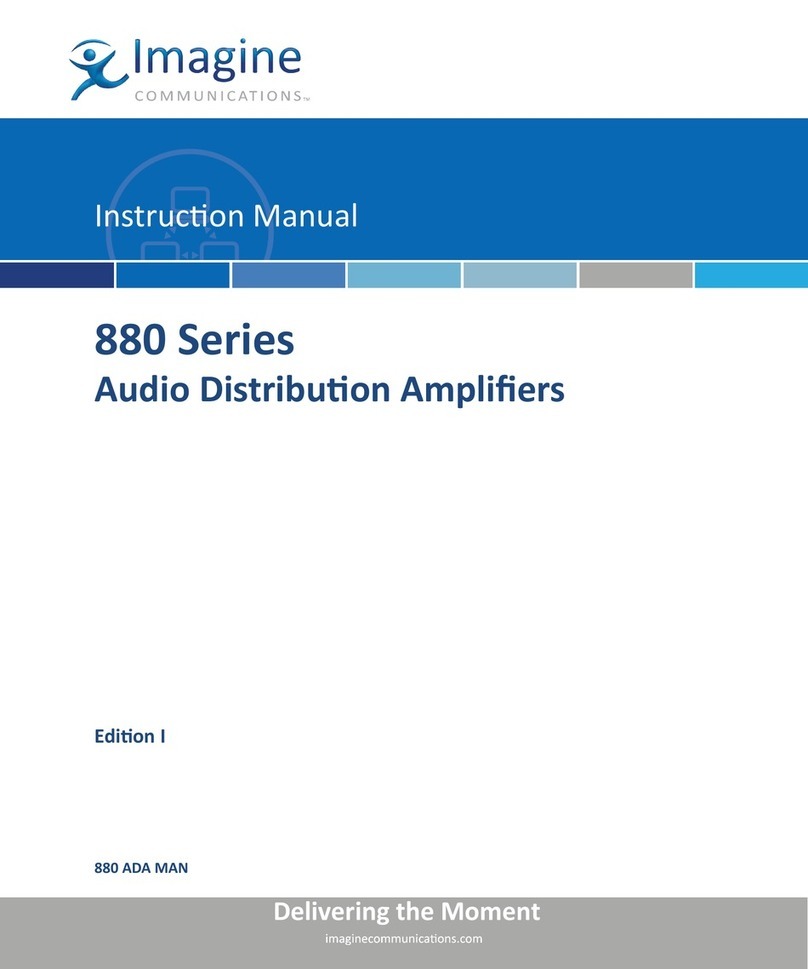
Harris
Harris 880 Series User manual
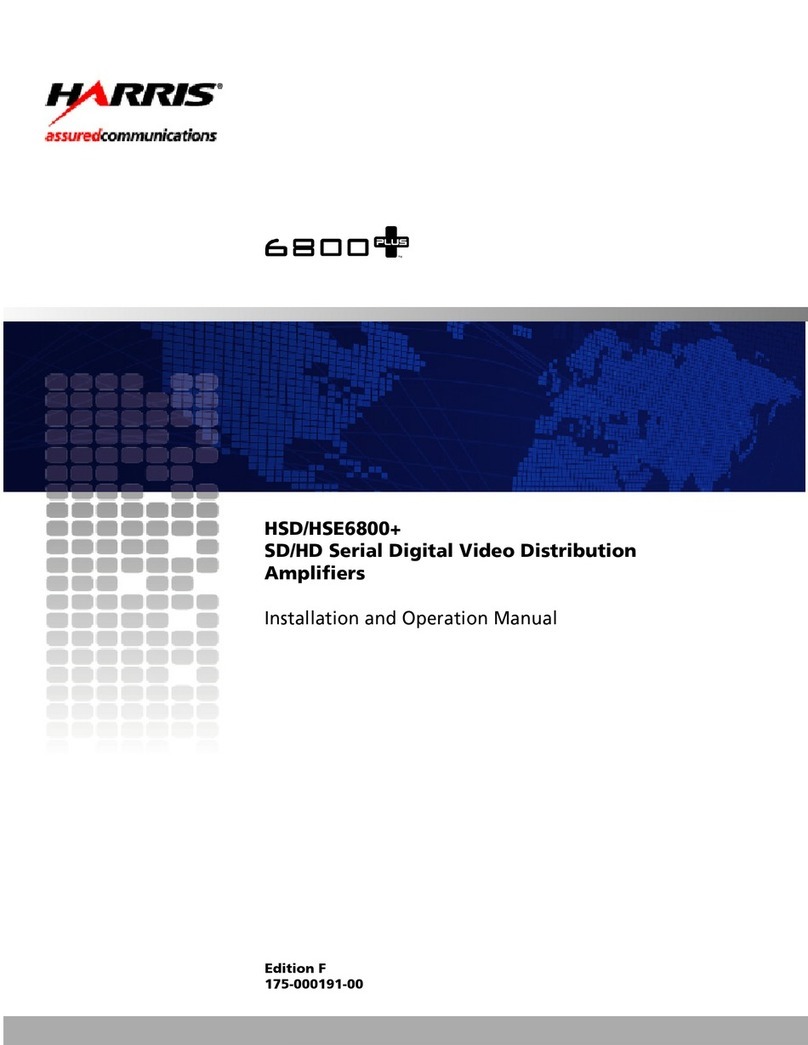
Harris
Harris HSD6800+ User manual
Popular Amplifier manuals by other brands

Panasonic
Panasonic FX-305 instruction manual
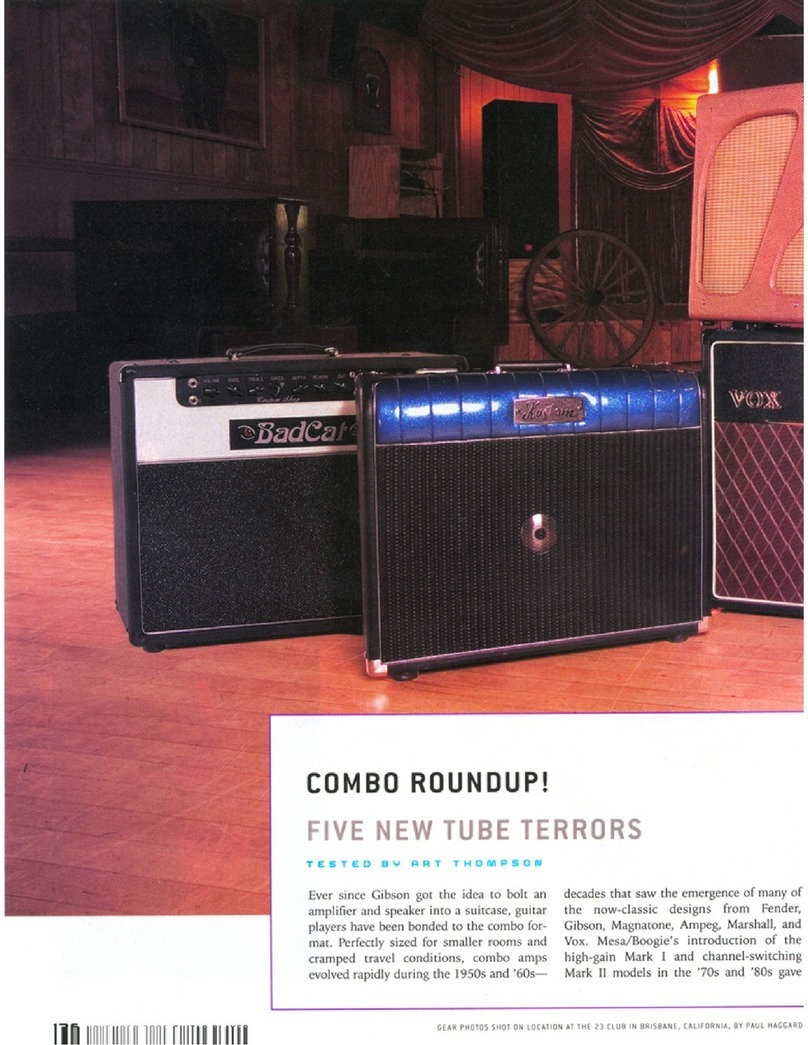
Kustom
Kustom Amplifier/Speaker brochure
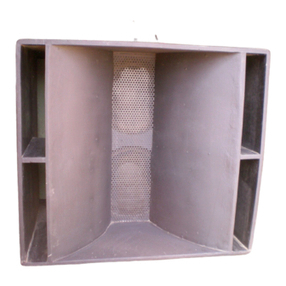
Altec Lansing
Altec Lansing 817 LF SPEAKER CABINET PLAN manual

LY International Electronics
LY International Electronics PM-2106 owner's manual
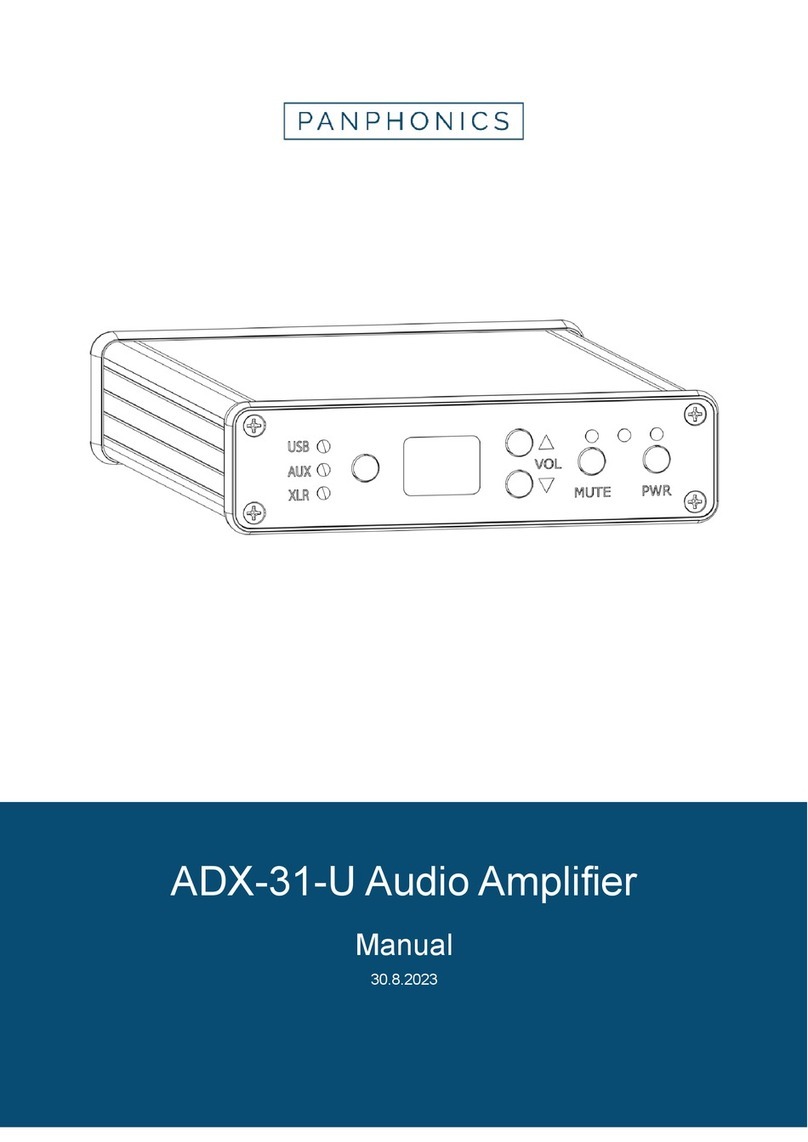
Panphonics
Panphonics ADX-31-U manual
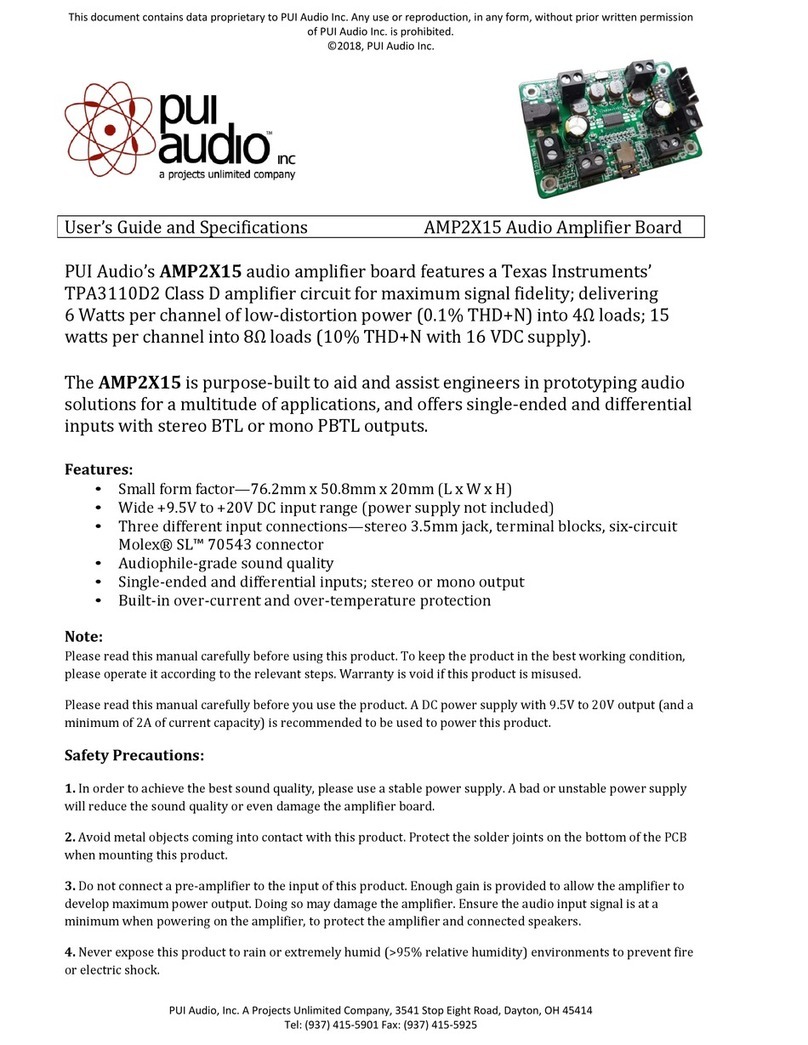
PUI Audio
PUI Audio AMP2X15 Product specifications and user's guide
